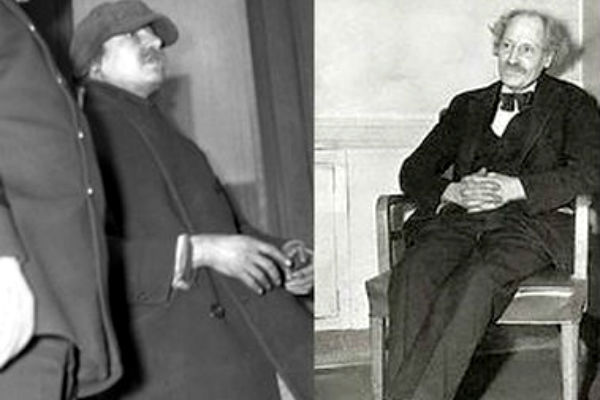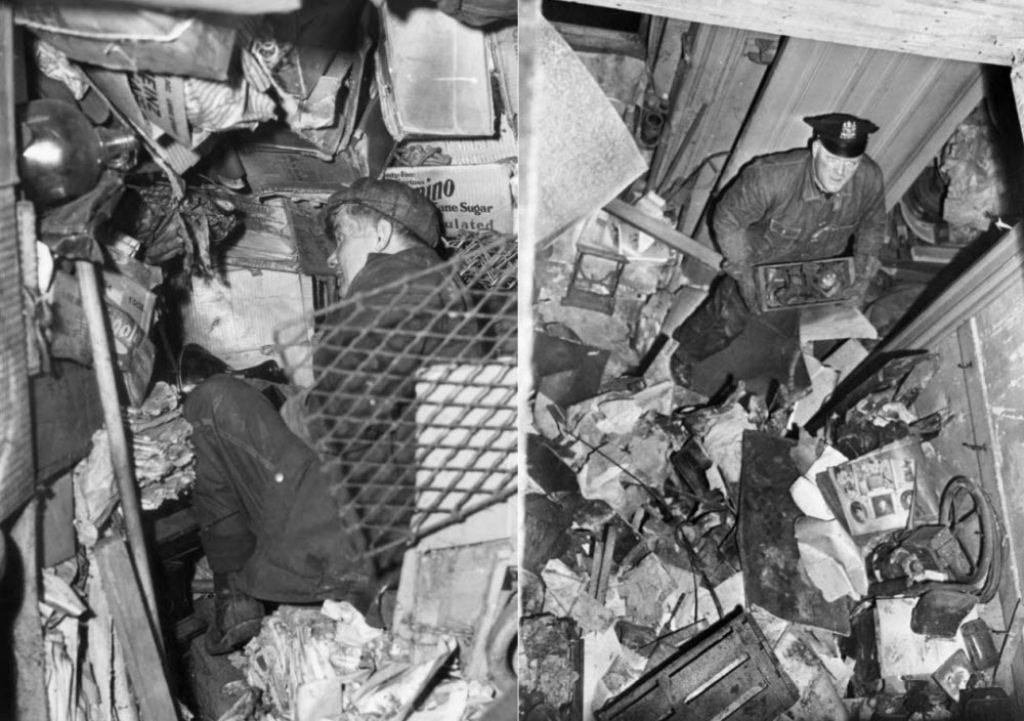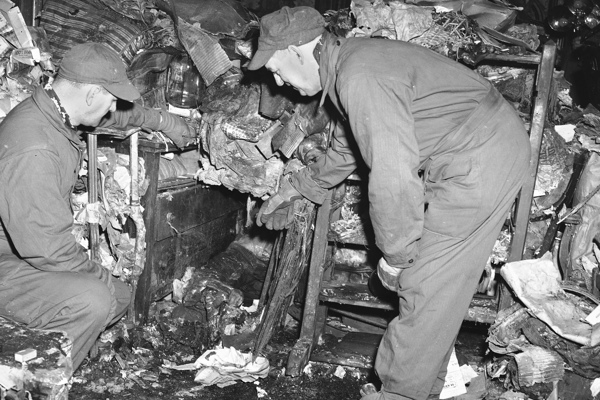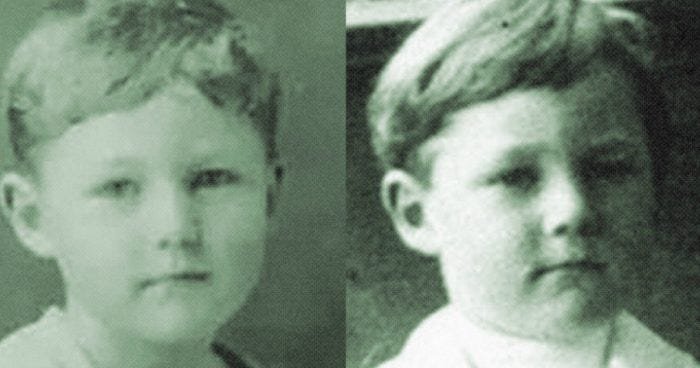On March 21, 1947, a Harlem resident noticed a foul stench in the air. It was coming from the once-grand brownstone mansion next door.
Everyone in the area knew the place. It was owned by the Collyer brothers. Two reclusive siblings who had lived there longer than anyone else in the neighborhood could remember.


Only one of them rarely ventured outside, and they were also known as hoarders. Their piles of junk could be seen through the windows from the street.
Alarmed by the odor, the neighbor alerted the authorities. When no one responded to the knocks at the door, the Police attempted to force their way in, but the door was blocked by so much junk that they couldn’t get in.
Finally, after breaching an upstairs window and navigating a path through mountains of newspapers, teetering stacks of books, and a labyrinth of forgotten objects, they made the grim discovery, the lifeless body of Homer Collyer. But the horror wasn’t over.
Days later, amidst the ongoing excavation of the house, the body of Langley Collyer, Homer’s brother and caretaker, was found mere feet away under an avalanche of junk.
This post will delve into the fascinating and disturbing story of the Collyer brothers, exploring their lives, their descent into hoarding, and the societal context that shaped their tragic fate.
The Collyer Brothers: Early Life And Background
Born into affluence, Homer and Langley Collyer seemed destined for lives of accomplishment and success.
Their parents, Dr. Herman and Susie Collyer, were descendants of prominent New York families, and the brothers grew up in a comfortable brownstone on Fifth Avenue.
Homer was the older of the two and was a brilliant student. He would graduate from Columbia University and later earn a law degree from New York Law School. He embarked on a successful career as a maritime lawyer.
Langley, equally gifted, displayed a passion for music and engineering. He graduated from Columbia with a degree in engineering and further honed his skills as a concert pianist.
The brothers’ early lives were a picture of promise and potential. They were well-educated, respected members of their community, and seemingly poised to make their mark on the world.
Yet, beneath the thin veneer of success, a darker reality was slowly taking shape. A series of events would trigger a gradual withdrawal from the world and set the stage for their descent into obsessive collecting.
Herman Collyer’s death in 1923 left Homer and Langley with not only his personal belongings but also a curious assortment of medical equipment and paraphernalia, all of which they transported to their Harlem residence.
When Susie Collyer passed away in 1929, the brothers inherited the entirety of her estate, including the brownstone itself.

The Great Migration, a mass exodus of African Americans from the South to northern cities, was in full swing during this time.
Harlem was rapidly becoming a vibrant center of black culture and community, but this shift also led to white families moving out to other segregated neighborhoods. The Collyers, however, remained behind in their old mansion as the world around them changed.
As the years passed, the brothers’ lives became even more isolated. Homer’s eyesight began to fail, leaving him dependent on Langley’s care. Langley, in turn, became increasingly protective of his brother.
Their once-vibrant lives dwindled into a monotonous routine of collecting and accumulating. Their possessions became a physical manifestation of their growing anxieties and fears.
Accumulated Chaos: Inside The Collyer Mansion
Stepping into the Collyer mansion was like stepping into a time capsule of accumulated junk. Narrow pathways snaked through towering stacks of decades old newspapers. Precariously balanced piles of books threatened to topple at the slightest touch.
Old furniture, broken appliances, and countless other objects lay scattered throughout the house, creating a treacherous obstacle course that only the brothers knew how to navigate.
In this self-imposed labyrinth, Homer and Langley carved out a semblance of normalcy amidst the chaos. Their daily lives were governed by a rigid routine dictated by Homer’s blindness and Langley’s unwavering devotion to caring for him.
Langley would leave the house under the cover of darkness to scavenge for food, newspapers, and any other items that caught his fancy. He would return laden with his treasures, adding to the ever-growing collection that filled their home.
Homer, confined to his bed, spent his days immersed in the world of books and newspapers, his mind a repository of knowledge and trivia.
He relied on Langley for everything, from food and water to companionship and entertainment.
Fearful of intruders and driven by a growing paranoia, Langley rigged the house with an elaborate network of booby traps. Tripwires, hidden tunnels, and strategically placed objects transformed the mansion into a perilous maze.
Mental Illness And Stigma In The Early 20th Century
The early 20th century was a time when mental illness was shrouded in ignorance, fear, and prejudice.
Societal attitudes toward mental health were largely shaped by a combination of religious beliefs, superstition, and a lack of scientific understanding.
Mental illness was often viewed as a moral failing, a sign of weakness or sin, rather than a legitimate medical condition.
Those afflicted were often ostracized, labeled as “insane” or “lunatics,” and subjected to harsh treatments that ranged from confinement in asylums to dubious medical interventions.
The common treatment options for mental illness during this era were often crude and ineffective.
Asylums, while intended to provide care and refuge, often became overcrowded and understaffed institutions where patients were subjected to neglect and abuse.
Treatments such as lobotomies and electroshock therapy were also employed, with little to no oversight.
In this climate of fear and misunderstanding, seeking help for mental health issues was often seen as a shameful act, carrying the risk of social ostracism and further discrimination.
This stigma likely played a significant role in the Collyer brothers’ tragic story.
As their compulsive hoarding escalated and their isolation deepened, they may have been reluctant to reach out for help, fearing judgment and condemnation from their community.
The Grim Discovery
On that fateful day in March 1947, after hours of battling through the accumulated debris, Police reached an upstairs bedroom where, amidst the towering stacks of newspapers and books, they found the emaciated body of Homer Collyer. He lay lifeless on a makeshift bed.
The medical examiner determined that Homer had succumbed to starvation and had been dead for about 10 hours. Not enough time to produce the smell of decomposition that the neighbor had reported.
The search for Langley continued for several more days as rescuers painstakingly removed junk from the house.
Finally, 18 days after finding Homer’s body, they discovered Langley’s body inside a makeshift tunnel. It was just a few feet away from where Homer’s body was discovered. He had been crushed beneath a cascade of debris, triggered by one of his own booby traps while bringing food to his brother.
The Aftermath And Legacy Of The Collyer Brothers
The cleanup of the Collyer mansion was a monumental undertaking. It took weeks for crews to remove the estimated 130 tons of junk, ranging from newspapers and books to pianos and a dismantled Model T Ford that they used to generate electricity.

The house itself, deemed structurally unsound due to the weight of the accumulated clutter, was ultimately demolished. The vacant lot that remained was turned into a pocket park honoring the brothers.
While mental health was largely misunderstood during their time, their story has led to a better understanding of the hoarding disorder and its devastating consequences.
The Collyer brothers’ story continues to be reimagined and referenced in literature and film. Their legacy is a complex one, marked by both tragedy and a profound impact on our understanding of the human mind.
The Collyer brothers may be gone, but their story lives on as a reminder of the fragility of the human psyche and the importance of recognizing and addressing mental health issues.
Sources
https://en.wikipedia.org/wiki/Collyer_brothers
https://www.nycgovparks.org/about/history/historical-signs/listings?id=7845













Leave a comment